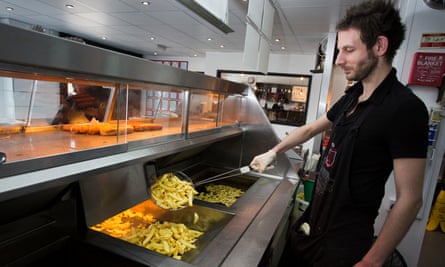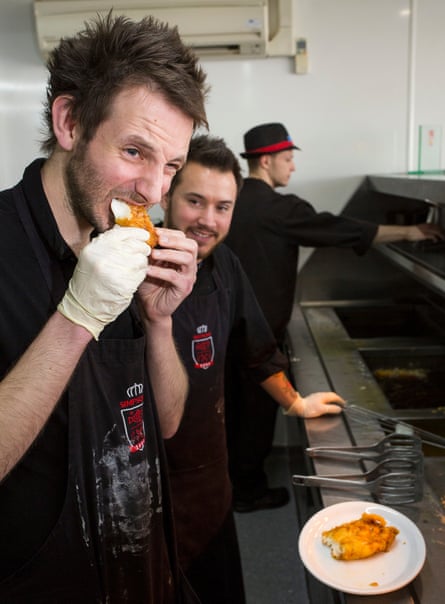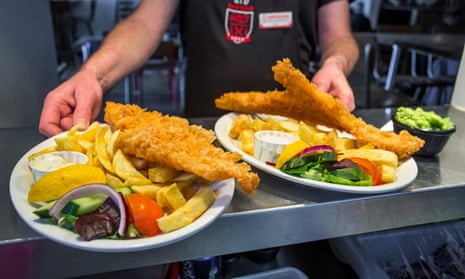I never thought I’d know what it feels like to be Katie Hopkins – I don’t really go out of my way to upset people. That changed when I made public my opinions about fish and chips earlier this year. I have since learned what it’s like for the internet to scream that you’re as popular as venereal disease.
I think our national dish is overrated – I just don’t get what people love about it, and I wrote 600 words about how I was born and raised in Birmingham by a family of second-generation immigrants who left Cyprus for a better life serving oily cod to Brummies. And that I still didn’t get its appeal despite living a lifetime among deep-fat fryers.
“Just go somewhere quiet and die there. You have nothing to contribute to human progress, you pointless philistine,” ran the comments. Chippy owners contacted me en masse to complain. The editor of Chippy Chat magazine took time out to tell me that I’d personally undone thousands of pounds’ worth of industry investment to promote fish and chips as healthy. And, eventually, I was invited to see how wrong I was about a supposedly rapidly changing industry by working a half-day shift in Simpsons in Cheltenham, the independent takeaway fish and chip shop of the year. I didn’t refuse. After all, I’m not Katie Hopkins. I am willing to consider the fact that I’m wrong.

“People are so protective over their chippies,” chuckles James Ritchie, proprietor of Simpsons, as I don my apron for the shift and run through some of the responses I received. “But, honestly, don’t worry – I just want to show you what nice fish and chips is like,” he continues. “I’m not going to hold your head over the deep-fat fryer, promise.” Reassuring.
As Ritchie gives me an introductory tour, it pretty quickly becomes obvious that things have changed a lot since the days when my uncle Tony would dye his mushy peas a lurid Shrek green. (Or, as one reader delicately put it: “Your uncle’s chippy was shite.”) Once a month, Simpsons holds “gluten-free Monday”, when it removes all pies and bread from the menu and whips up batter using rice flour. There are signs proudly boasting the sustainability of their fish and, in their spare time, the proprietors run a street-food fish and chip van. Still, as we wander into a storeroom containing bucket-sized jars of pickled eggs, I realise that some things never change in chippyland: in particular, the popularity of weirdly vinegary farmyard produce. “Actually, we tend to sell more of our homemade ‘frickles’ – deep-fried pickles,” says James. Hmm. Birmingham in the 90s, this is not.

“You know: you’re right about fish and chips, though,” says James as my on-the-job training begins. “Done wrong, it’s a terrible meal and I have definitely eaten enough to know that it happens a lot.” He’s not alone. The thing that prompted me to write my piece was a government study, which found that the number of Brits visiting their chippy had more than halved between 1974 and 2014. Not that surprising, really – the whole meal is simmered in oil. It’s hard to think of anything less healthy – which isn’t exactly going to please a nation hepped up on Deliciously Ellas and Veganuaries. “It’s actually one of the most healthy takeaways you can have, if it’s done right,” counters Ritchie. I nod politely. This is one claim I’m taking with a heavy pinch of salt.
And then my training in “frying properly” begins. The fish and the chips must always be fried in separate oil (the sugar content in potatoes can damage the oil and make the fish overly greasy). Fish is fried at 185C, chips at 175C. Serving the food in a paper wrapper is a bad idea. Much better to put it into a cardboard box, “otherwise you’ll make it sweat”. When you’re cutting cod and haddock into portion sizes, you need to be digital-scale precise (medium pieces are 6-7oz, large are 8-9oz) lest you want to leave customers feeling like they’re digesting a bowling ball. And when you’re frying fish, it’s best to wear plastic gloves, because if hot oil gets splashed on to your hands, “you can’t peel off skin. Well, unless it’s a really bad burn.”

“You’ll get the hang of it,” Ritchie tells me encouragingly, as I stumble around dropping battered sausages on to my trainers. I dunk some fish into batter, then slide them into what is called the “pan” – a rectangular vat of boiling oil that’s twice the size of most kitchen sinks. I’m told that you know the fish is done when it floats up to the surface, and Ritchie asks me to skim the oil to remove the little flakes of batter that separate so that they don’t burn and flavour the oil.
“How do you fancy trying the front of house?” he asks. I oblige and, preparing a customer’s order, I go to lift the cod I cooked. “Wait!” hisses Ritchie. “Sorry, we can’t serve that – it’s not properly battered.” Clearly I’m not cut out for this. I hang my apron up. Shift over.
Finally, it’s judgment time. “You’ll be wanting to taste the fish and chips then?” asks Ritchie. After all, I’m here to see if good fish and chips can be a culinary joy. And it turns out that it can. I’m not so keen on the cod (Simpsons use frozen fish because of textural preference, but it’s a little chewy for my liking). The chips were chips. The haddock, though, is a delight – as tender as an Adele song. And a portion of salty battered halloumi makes me want to clip my Greek Cypriot relatives around the ear for not thinking of it first. Is it enough to change my mind about fish and chips completely? Probably not. But it’s a lot more enjoyable than most offerings I’ve had. And, unlike almost all other chippy lunches I’ve eaten, I don’t feel like I want to lie on the floor, groaning.
“Yeah, we actually had the food nutritionally tested,” says James. “Seven hundred calories for a regular cod, chips and peas. Only 1.2% saturated fat.” WHAT? Fish and chips doesn’t clog your arteries? “Nope. It’s way healthier than a McDonald’s.”
Oh. Right. Maybe I was wrong about fish and chips after all.

Comments (…)
Sign in or create your Guardian account to join the discussion